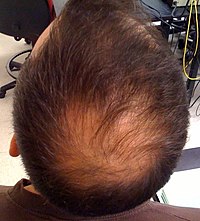
Photo from wikipedia
A previously healthy 64-year-old woman presented with a 3-day history of erythema and vesicles on the left arm and hand. She indicated that she had been scratched by a stray… Click to show full abstract
A previously healthy 64-year-old woman presented with a 3-day history of erythema and vesicles on the left arm and hand. She indicated that she had been scratched by a stray cat on the left forearm earlier. There is no fever or other discomfort. The initial diagnosis of cat scratch disease was considered, and a skin biopsy was performed. Five days later, she returned and the eruptions became getting worse. Meanwhile, new tender lesions had progressively appeared on her hands in the previous 2 days. Physical examination showed central crusted edematous erythematous plaques and a scratch on the left arm and hand (Fig. 1a) with multiple target-shaped erythematous papules symmetrically on her hands (Fig. 1b). Histopathological sections demonstrated exudation, crusting in epidermis, obviously edema in the superficial dermis and lymphocytes, histiocytes and scanty eosinophils infiltration around the blood vessels in dermis. PAS stain showed hyphae in the stratum corneum and hair follicles (Fig 1c). No Warthin– Starry-positive Bartonella henselae could be detected. Laboratory studies revealed leukocytosis (13.2 * 10/ L) and hypersensitive C-reactive protein 35 mg/L (normal, 0–10 mg/L). Serologic tests for HSV I/II were negative. Fungal culture showed white fluffy spread colonies and deep yellow-orange pigment on the reverse (Fig. 1d). The internal transcribed spacer regions of ribosomal DNA were sequenced and identified as Microsporum canis (M. canis). A diagnosis of erythema multiforme associated with tinea of vellus hair caused by M. canis was made. Terbinafine 250 mg/day and prednisone 0.5 mg/ kg/day with topical terbinafine cream were given as treatment. Erythema multiforme lesions had cleared 1 week later. Therefore, prednisone was withdrawn and terbinafine continued to be prescribed for 6 weeks. During 3 months of follow-up, the cutaneous lesions were wholly resolved. Erythema multiforme is a self-limited hypersensitivity skin reaction mostly caused by drug and infectious factors. The association of erythema multiforme with deep mycotic infections is relatively common. However, erythema multiforme with dermatophytosis is rare. Tinea of vellus hair is an uncommon manifestation of dermatophytosis. In a high percentage of cases of tinea of vellus hair, no hyphae are observed on the scales, the parasitism being exclusive to the hair. However, we present the first case of tinea of vellus hair, in which hyphae were found not only in the stratum corneum but also within the hair follicle by histopathology. Excoriation by a stray cat may play a role in the development of the tinea of the vellus hair, making some dermatophytes located in the stratum corneum penetrate into the hair follicle. It is important to distinguish tinea of vellus hair from Majocchi’s granuloma. Majocchi’s granuloma is a rare granulomatous folliculitis, which demonstrates
Journal Title: Mycopathologia
Year Published: 2019
Link to full text (if available)
Share on Social Media: Sign Up to like & get
recommendations!